-
 Bitcoin
Bitcoin $83,602.2353
-2.17% -
 Ethereum
Ethereum $1,577.6270
-3.79% -
 Tether USDt
Tether USDt $0.9999
0.02% -
 XRP
XRP $2.0682
-3.29% -
 BNB
BNB $580.5372
-1.35% -
 Solana
Solana $125.9599
-4.13% -
 USDC
USDC $0.9999
0.01% -
 TRON
TRON $0.2526
0.40% -
 Dogecoin
Dogecoin $0.1542
-3.28% -
 Cardano
Cardano $0.6077
-5.21% -
 UNUS SED LEO
UNUS SED LEO $9.3476
-0.85% -
 Chainlink
Chainlink $12.2682
-3.17% -
 Avalanche
Avalanche $18.8394
-5.46% -
 Stellar
Stellar $0.2340
-2.50% -
 Toncoin
Toncoin $2.8622
-2.26% -
 Shiba Inu
Shiba Inu $0.0...01168
-1.90% -
 Sui
Sui $2.1011
-4.06% -
 Hedera
Hedera $0.1573
-5.64% -
 Bitcoin Cash
Bitcoin Cash $322.1078
-3.54% -
 Litecoin
Litecoin $75.9738
-2.48% -
 Polkadot
Polkadot $3.5448
-3.26% -
 Dai
Dai $1.0000
0.01% -
 Bitget Token
Bitget Token $4.2295
-2.19% -
 Hyperliquid
Hyperliquid $14.9181
-7.99% -
 Ethena USDe
Ethena USDe $0.9991
0.01% -
 Pi
Pi $0.6195
-16.55% -
 Monero
Monero $218.5657
3.31% -
 Uniswap
Uniswap $5.1727
-3.85% -
 OKB
OKB $52.2344
0.01% -
 Pepe
Pepe $0.0...07065
-4.74%
What is the difference between ZK-Rollup and Optimistic Rollup for blockchain?
ZK-Rollup uses zero-knowledge proofs for secure, private transactions with immediate finality, while Optimistic Rollup relies on fraud proofs, offering scalability but with delays.
Apr 14, 2025 at 07:07 pm
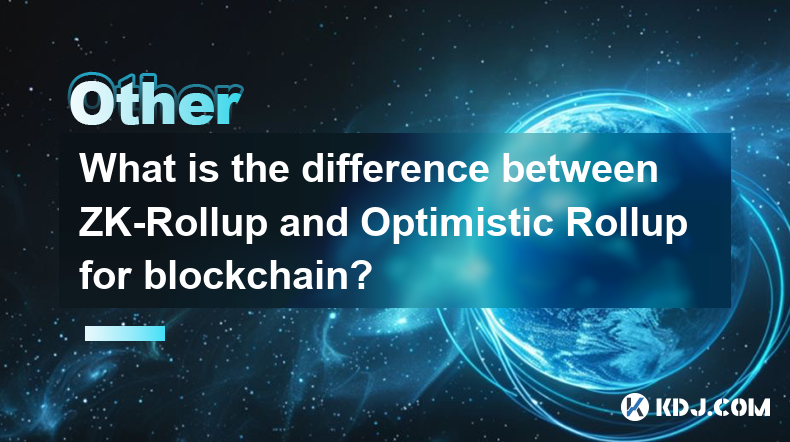
Introduction to Layer 2 Scaling Solutions
In the world of blockchain, scalability is a significant concern. As more users and transactions are added to the network, the system can become slow and expensive. To address this, developers have created Layer 2 scaling solutions like ZK-Rollup and Optimistic Rollup. These technologies aim to increase transaction throughput and reduce costs while maintaining the security of the underlying blockchain. Understanding the differences between ZK-Rollup and Optimistic Rollup is crucial for anyone interested in the future of blockchain scalability.
What is ZK-Rollup?
ZK-Rollup stands for Zero-Knowledge Rollup. It is a Layer 2 scaling solution that uses zero-knowledge proofs to batch multiple transactions into a single transaction on the main blockchain. This approach significantly reduces the data that needs to be stored on the blockchain, thereby increasing scalability.
In ZK-Rollup, the transactions are processed off-chain, and only the proof of the transaction's validity is submitted to the main blockchain. This method ensures that the transactions are secure and verifiable without revealing the details of the transactions. ZK-Rollup is particularly valued for its high security and privacy features, as it does not require users to trust the operator of the rollup.
How ZK-Rollup Works
To understand how ZK-Rollup functions, let's break down the process:
- Transaction Collection: Multiple transactions are collected off-chain by the ZK-Rollup operator.
- Transaction Processing: These transactions are processed and grouped into a batch.
- Zero-Knowledge Proof Generation: A zero-knowledge proof is generated to verify the validity of the batch without revealing the transaction details.
- Submission to Main Chain: The proof and minimal data (e.g., account balances) are submitted to the main blockchain.
- Verification: The main blockchain verifies the proof, ensuring the batch of transactions is valid.
This method allows ZK-Rollup to achieve high throughput and low transaction fees while maintaining the security and privacy of the blockchain.
What is Optimistic Rollup?
Optimistic Rollup is another Layer 2 scaling solution that aims to increase the scalability of blockchain networks. Unlike ZK-Rollup, Optimistic Rollup assumes that all transactions are valid by default and only performs validation if a fraud proof is submitted.
In Optimistic Rollup, transactions are also processed off-chain, but the full transaction data is stored on the main blockchain. This allows for greater transparency but comes with a longer withdrawal period, as users must wait for a challenge period to pass before their funds can be moved back to the main chain.
How Optimistic Rollup Works
The process of Optimistic Rollup can be described as follows:
- Transaction Submission: Users submit transactions to the Optimistic Rollup operator.
- Transaction Processing: The operator processes these transactions off-chain and posts the transaction data to the main blockchain.
- Challenge Period: A challenge period is initiated, during which anyone can submit a fraud proof if they believe a transaction is invalid.
- Verification: If no fraud proof is submitted within the challenge period, the transactions are considered valid and finalized.
- Withdrawal: After the challenge period, users can withdraw their funds to the main blockchain.
This approach allows Optimistic Rollup to achieve high scalability but requires a longer time for transaction finality and withdrawal.
Key Differences Between ZK-Rollup and Optimistic Rollup
Understanding the key differences between ZK-Rollup and Optimistic Rollup is essential for choosing the right scaling solution for specific use cases. Here are the main points of comparison:
Security and Privacy: ZK-Rollup offers higher security and privacy as it uses zero-knowledge proofs to validate transactions without revealing transaction details. Optimistic Rollup relies on fraud proofs and requires users to trust the operator during the challenge period, which can be less secure and less private.
Transaction Finality: ZK-Rollup achieves immediate transaction finality as the proof is verified on the main blockchain. Optimistic Rollup requires a challenge period, which can delay transaction finality and withdrawal times.
Scalability: Both solutions offer significant scalability improvements, but ZK-Rollup can process transactions more quickly due to the immediate finality, while Optimistic Rollup may have slightly higher throughput due to less complex validation processes.
Complexity and Cost: ZK-Rollup is more complex and computationally intensive due to the need for zero-knowledge proofs, which can result in higher operational costs. Optimistic Rollup is simpler to implement and operate, leading to lower costs for the operator.
Use Cases for ZK-Rollup and Optimistic Rollup
The choice between ZK-Rollup and Optimistic Rollup depends on the specific requirements of the blockchain application. Here are some use cases for each:
ZK-Rollup: Ideal for applications that require high security and privacy, such as decentralized finance (DeFi) platforms, where users need to ensure the confidentiality of their transactions. It is also suitable for applications that require immediate transaction finality, such as high-frequency trading platforms.
Optimistic Rollup: Suitable for applications that prioritize scalability and lower operational costs, such as gaming platforms or social media applications on the blockchain. It is also a good choice for applications where users are willing to wait for a challenge period to ensure transaction validity.
Conclusion
Both ZK-Rollup and Optimistic Rollup are powerful Layer 2 scaling solutions that address the scalability challenges faced by blockchain networks. While ZK-Rollup offers higher security and privacy with immediate transaction finality, Optimistic Rollup provides greater scalability and lower costs with a longer withdrawal period. Understanding these differences is crucial for developers and users looking to leverage these technologies to enhance the performance of their blockchain applications.
Frequently Asked Questions
Q1: Can ZK-Rollup and Optimistic Rollup be used together in a single blockchain network?
Yes, it is possible to use both ZK-Rollup and Optimistic Rollup within the same blockchain network. This approach can provide a hybrid solution that leverages the strengths of both technologies. For example, a network could use ZK-Rollup for transactions requiring high privacy and security and Optimistic Rollup for transactions where scalability and lower costs are more important.
Q2: How do the gas fees compare between ZK-Rollup and Optimistic Rollup?
Gas fees for ZK-Rollup are generally lower than those for Optimistic Rollup because ZK-Rollup only submits minimal data and a proof to the main blockchain. Optimistic Rollup, on the other hand, submits full transaction data, which can result in higher gas fees. However, the exact fees can vary depending on the specific implementation and the blockchain network.
Q3: Are there any specific blockchain networks that have adopted ZK-Rollup or Optimistic Rollup?
Several blockchain networks have adopted these scaling solutions. For example, Ethereum has seen the implementation of both ZK-Rollup and Optimistic Rollup. Projects like Loopring and StarkWare use ZK-Rollup, while Arbitrum and Optimism utilize Optimistic Rollup. These implementations demonstrate the practical application of these technologies in real-world blockchain networks.
Q4: How does the user experience differ between ZK-Rollup and Optimistic Rollup?
The user experience with ZK-Rollup is generally smoother due to immediate transaction finality, which means users can quickly confirm their transactions. With Optimistic Rollup, users may experience a delay due to the challenge period, which can affect the speed of withdrawals and overall user satisfaction. However, both solutions aim to provide a seamless experience by handling most of the complexity behind the scenes.
Disclaimer:info@kdj.com
The information provided is not trading advice. kdj.com does not assume any responsibility for any investments made based on the information provided in this article. Cryptocurrencies are highly volatile and it is highly recommended that you invest with caution after thorough research!
If you believe that the content used on this website infringes your copyright, please contact us immediately (info@kdj.com) and we will delete it promptly.
- Avalon Labs Has Launched the Institutional Yield Layer on Bybit Earn, Opening Bitcoin to DeFi
- 2025-04-16 14:25:14
- Chipmaking giants Nvidia and AMD have seen their share prices slide
- 2025-04-16 14:25:14
- ChatGPT-4.5, OpenAI's Latest Innovation, Has Reached a Decisive Milestone by Passing the Turing Test with an Impressive Success Rate of 73%
- 2025-04-16 14:20:12
- Bitcoin (BTC) Price Up 9% Over The Past Week, Targeting $90,000 Resistance
- 2025-04-16 14:20:12
- A crypto game inspired by Monopoly is reportedly on the horizon
- 2025-04-16 14:15:13
- A Stablecoin To Beat Inflation?
- 2025-04-16 14:15:13
Related knowledge

Can the application of blockchain in supply chain finance bring benefits?
Apr 15,2025 at 04:00pm
Can the application of blockchain in supply chain finance bring benefits? The integration of blockchain technology into supply chain finance has garnered significant attention in the cryptocurrency and financial sectors. This article explores how blockchain can potentially revolutionize supply chain finance, detailing its benefits and providing a compre...
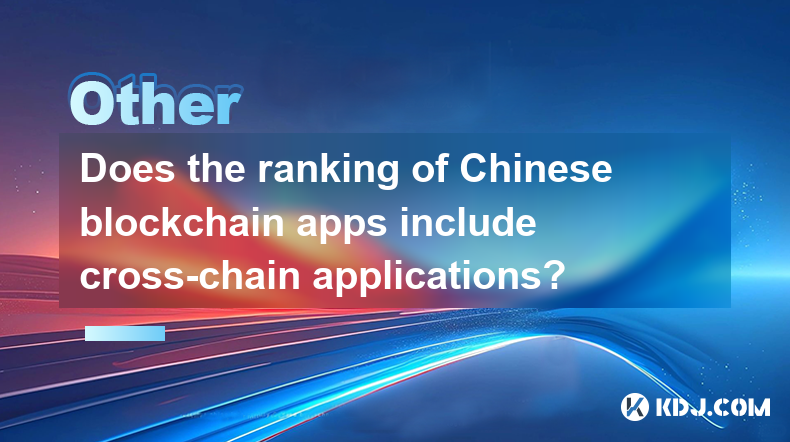
Does the ranking of Chinese blockchain apps include cross-chain applications?
Apr 14,2025 at 04:00pm
The ranking of Chinese blockchain apps is a comprehensive evaluation that takes into account various aspects such as user base, transaction volume, and technological innovation. A pertinent question arises regarding whether these rankings include cross-chain applications. Cross-chain applications, which allow different blockchain networks to interact an...
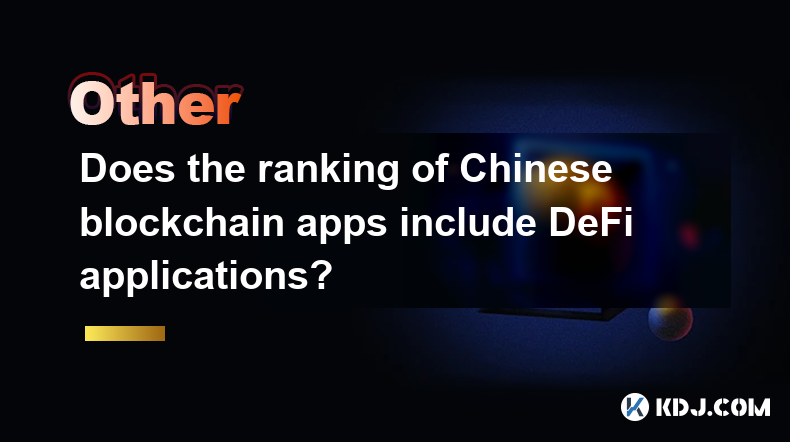
Does the ranking of Chinese blockchain apps include DeFi applications?
Apr 15,2025 at 06:57am
The ranking of Chinese blockchain apps is a comprehensive list that showcases the most popular and influential applications within the cryptocurrency ecosystem. One question that often arises is whether these rankings include DeFi applications. To answer this, we need to delve into the specifics of how these rankings are compiled and what types of appli...
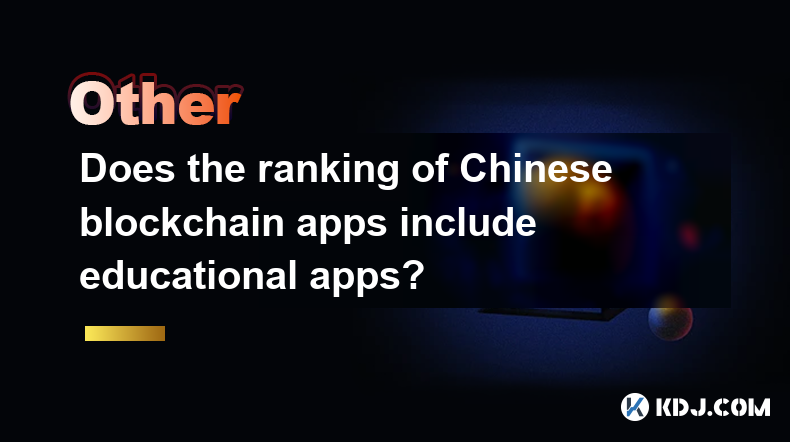
Does the ranking of Chinese blockchain apps include educational apps?
Apr 16,2025 at 03:35am
The ranking of Chinese blockchain apps often includes a variety of categories, from finance and gaming to social networking and beyond. One question that frequently arises is whether these rankings include educational apps. To address this, we need to delve into the specifics of how blockchain apps are categorized and ranked in China, and whether educat...
Does the ranking of Chinese blockchain apps include enterprise-level applications?
Apr 15,2025 at 06:42am
The ranking of Chinese blockchain apps often includes a variety of applications, ranging from consumer-focused to enterprise-level solutions. Understanding the scope and criteria for these rankings is essential to determine if enterprise-level applications are included. This article delves into the specifics of how Chinese blockchain app rankings are co...
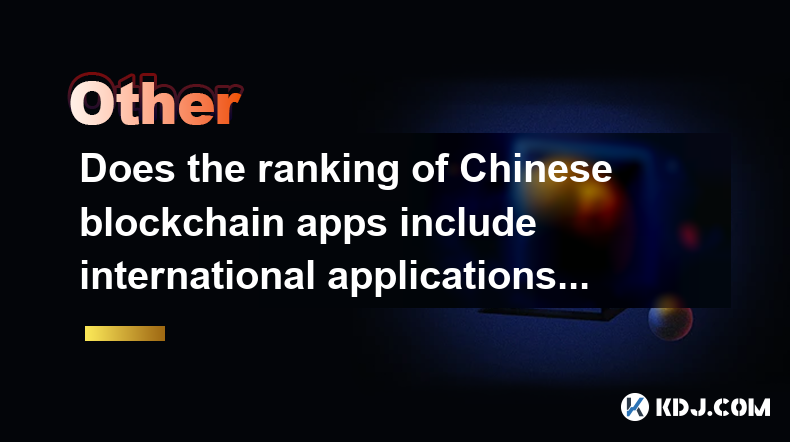
Does the ranking of Chinese blockchain apps include international applications?
Apr 16,2025 at 04:07am
The ranking of Chinese blockchain apps primarily focuses on applications developed and predominantly used within China. However, the question of whether these rankings include international applications is an intriguing one that warrants a detailed exploration. In this article, we will delve into the criteria used for ranking Chinese blockchain apps, th...

Can the application of blockchain in supply chain finance bring benefits?
Apr 15,2025 at 04:00pm
Can the application of blockchain in supply chain finance bring benefits? The integration of blockchain technology into supply chain finance has garnered significant attention in the cryptocurrency and financial sectors. This article explores how blockchain can potentially revolutionize supply chain finance, detailing its benefits and providing a compre...

Does the ranking of Chinese blockchain apps include cross-chain applications?
Apr 14,2025 at 04:00pm
The ranking of Chinese blockchain apps is a comprehensive evaluation that takes into account various aspects such as user base, transaction volume, and technological innovation. A pertinent question arises regarding whether these rankings include cross-chain applications. Cross-chain applications, which allow different blockchain networks to interact an...

Does the ranking of Chinese blockchain apps include DeFi applications?
Apr 15,2025 at 06:57am
The ranking of Chinese blockchain apps is a comprehensive list that showcases the most popular and influential applications within the cryptocurrency ecosystem. One question that often arises is whether these rankings include DeFi applications. To answer this, we need to delve into the specifics of how these rankings are compiled and what types of appli...

Does the ranking of Chinese blockchain apps include educational apps?
Apr 16,2025 at 03:35am
The ranking of Chinese blockchain apps often includes a variety of categories, from finance and gaming to social networking and beyond. One question that frequently arises is whether these rankings include educational apps. To address this, we need to delve into the specifics of how blockchain apps are categorized and ranked in China, and whether educat...

Does the ranking of Chinese blockchain apps include enterprise-level applications?
Apr 15,2025 at 06:42am
The ranking of Chinese blockchain apps often includes a variety of applications, ranging from consumer-focused to enterprise-level solutions. Understanding the scope and criteria for these rankings is essential to determine if enterprise-level applications are included. This article delves into the specifics of how Chinese blockchain app rankings are co...

Does the ranking of Chinese blockchain apps include international applications?
Apr 16,2025 at 04:07am
The ranking of Chinese blockchain apps primarily focuses on applications developed and predominantly used within China. However, the question of whether these rankings include international applications is an intriguing one that warrants a detailed exploration. In this article, we will delve into the criteria used for ranking Chinese blockchain apps, th...
See all articles























































































